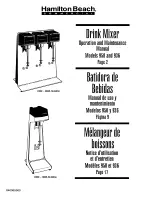
Onyx P
remium Analog Mix
er with Multi-
Tr
ack USB
Onyx Premium Analog Mixer with Multi-Track USB
30
Now let's take a look at the SD transport controls.
Left to right, they are:
(A) Returns to the beginning of the current track
when pressed once. It will return to previous tracks
when pressed repeatedly – the button will illuminate
white, but for a moment.
(B) Skips to the next track – the button will illuminate
white, but for a moment.
(C) Starts a new recording – the button will
illuminate and flash white. Additionally, the play / pause
button will illuminate solid white during recording.
If the record button is tapped during
a recording, the current recording stops
and a new one begins immediately.
(D) Starts / pauses playback of the current track –
the button will illuminate solid white during playback
and flashes while paused. If no track is playing /
paused, it will start playback of the highlighted track.
If the ‘Record’ button is active, pressing this button
will play or pause the recording process.
The back and forward buttons function
as a stop button when in pause mode.
Press one or the other, but not both.
If both buttons are pressed simultaneously,
the mixer will self-destruct.
Recording
– Now that an SD card has been formatted
and inserted into the SD card slot, it's time to make
a recording... the fun begins!
Let's start with a simple test run. Plug something
into the channel 1 input. This could be a mic,
instrument (with the Hi-Z switch down), phone, etc.
Make sure the levels are set correctly (see page 5).
Press the SD button to enter SD recording / playback
mode. The LCD screen will looks similar to what
is displayed below.
STEREO RECORDING
AND PLAYBACK
A
C
B
D
PLAYBACK
ONYX
REC
“Onyx” is the parent directory and may not
be accessed. That said, there are no files
that will be needed, anyway.
Press the record button and start talking, singing,
yodeling, scatting, playing the instrument or playing
a track from the phone. Do this for a good 20 seconds,
or so.
Notice below that the LCD screen now displays
(1) a recording counter with the elapsed time in
the format of HH:MM:SS, (2) the current recording
track name and (3) the universal sign for recording –
“•” – is presented (not once, but twice!).
Once done, press the play / pause button to stop
the recording. Once several recordings have been
made, the LCD screen will look similar to what is
displayed below.
Notice how each recording has the previous
recording name plus one. This is standard, but it
may be tailored to your desire. More on that soon.
Rotate the Studio Command Control Knob to scroll
through all of the different recordings until the one
you desire to hear is highlighted: AUD00159.WAV
in the example shown above.
Playback
– First things first. Make sure that the SD
switch – located on the front panel near the top of
the second stereo channel strip – is engaged first.
This mutes the input and allows the SD card return
to flow through the channel instead.
This switch is located on the last stereo
channel strip 7/8 on the Onyx8.
RECORD
00:03:43
AUD00159.WAV
PLAYBACK
REC
AUD00157.WAV
AUD00156.WAV
AUD00158.WAV
AUD00159.WAV
















































